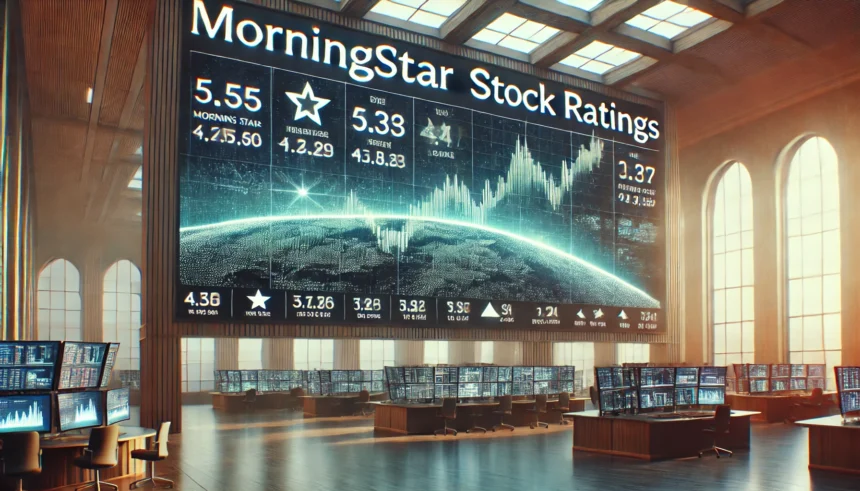Morningstar is one of the most well-known and respected financial research firms in the world. It provides investors with a wide range of tools and resources to help them make informed investment decisions. Among the most popular tools is the Morningstar stock ratings system, which evaluates individual stocks based on factors such as their valuation, economic position, and long-term potential. These ratings help both beginner and experienced investors assess whether a stock is a good buy or not.
Understanding how Morningstar rates stocks can help you make more informed decisions, optimize your portfolio, and ultimately achieve your investment goals.
What Are Morningstar Stock Ratings?
Morningstar stock ratings are a way of evaluating stocks based on their fair value and potential for long-term growth. They provide investors with a simple but effective system for deciding whether a stock is overvalued, fairly valued, or undervalued. These ratings help take some of the guesswork out of investing by offering a clear view of a stock’s current worth compared to its estimated future potential.
Key Components of Morningstar Stock Ratings
Morningstar’s stock ratings are based on several key factors that give a clear picture of a stock’s value and future prospects:
Star Ratings (1–5):
Morningstar uses a 5-star rating system, which is one of its most recognized features. Here’s what each rating means:
- 5 Stars: The stock is deeply undervalued, presenting an excellent investment opportunity.
- 4 Stars: The stock is somewhat undervalued, making it a good opportunity for investors.
- 3 Stars: The stock is fairly valued, meaning its market price is close to its estimated fair value.
- 2 Stars: The stock is slightly overvalued and may not provide much growth potential in the near future.
- 1 Star: The stock is significantly overvalued, meaning it carries a higher risk of price decline.
Fair Value Estimate:
The fair value estimate is Morningstar’s internal calculation of a stock’s true worth. It is based on a company’s future cash flows, revenue growth, and industry performance. This estimate helps investors assess whether a stock is priced higher or lower than its true value in the market.
Economic Moat:
Morningstar assesses a company’s “economic moat,” which is essentially a sustainable competitive advantage. Companies with strong economic moats, like Coca-Cola or Apple, are more likely to maintain profitability and growth over time. These companies can fend off competition and maintain high margins, providing a solid foundation for investors. Morningstar classifies companies as having a wide moat, narrow moat, or no moat at all.
Uncertainty Rating:
The uncertainty rating reflects how predictable a company’s future cash flows are. Companies with low uncertainty (such as utilities) have stable, predictable earnings, while those with high uncertainty (like biotechnology firms) face greater risks and fluctuations in revenue.
Analyst Reports:
Morningstar’s analysts provide qualitative assessments of companies, offering insights into their business models, management effectiveness, and market conditions. These reports are a valuable resource for investors, adding context to the quantitative ratings.
How Morningstar Assigns Stock Ratings
Morningstar uses a combination of quantitative models and qualitative analysis to assign stock ratings. The core of their analysis is the discounted cash flow (DCF) model, which estimates the present value of a company’s future cash flows. The analysts factor in elements such as revenue growth, operating expenses, and market conditions to determine the fair value estimate.
Additionally, Morningstar analysts consider factors like the company’s competitive position, management quality, and industry trends. This holistic approach helps Morningstar provide accurate and reliable ratings.
Understanding the Morningstar Star Ratings
Here’s a deeper dive into what the Morningstar star ratings signify:
5-Star Rating:
A stock with a 5-star rating is considered to be deeply undervalued. Morningstar believes this stock has significant upside potential based on its future growth prospects and market position. Investors looking for great long-term investments often seek out 5-star rated stocks.
4-Star Rating:
A 4-star rating suggests that the stock is undervalued but to a lesser extent. It still represents a good investment opportunity with potential for solid returns.
3-Star Rating:
A 3-star rating indicates that the stock is fairly valued. This means the stock is trading close to its intrinsic value, and while it might be a stable investment, it may not provide substantial upside.
2-Star Rating:
A stock with a 2-star rating is considered to be overvalued. It’s priced higher than its fair value, and investors may not see significant gains from it in the near future.
1-Star Rating:
A 1-star rating signifies that the stock is significantly overpriced. These stocks are at higher risk, and Morningstar suggests they might not be wise investments unless they undergo significant price adjustments.
Benefits of Morningstar Stock Ratings
Using Morningstar’s stock ratings can provide several advantages to investors:
- Clarity: The star ratings offer a quick and easy way to assess a stock’s value, simplifying the decision-making process.
- Long-Term Focus: Morningstar focuses on intrinsic value, encouraging long-term investing strategies rather than short-term speculation.
- Data-Driven Insights: Morningstar combines quantitative data with qualitative analysis to give a balanced view of a stock’s potential.
- User-Friendly Tools: The star rating system is simple to understand, making it accessible for all levels of investors.
Limitations of Morningstar Ratings
Despite their usefulness, there are some limitations to the Morningstar stock ratings:
- No Guarantees: Ratings are not foolproof. Even highly rated stocks can underperform in certain market conditions.
- Dependence on Assumptions: The fair value estimate relies on assumptions about future growth, which may change over time.
- Need for Additional Research: Investors should not rely solely on stock ratings. It’s important to conduct your own research and consider other factors, such as market conditions and personal investment goals.
How to Use Morningstar Ratings in Your Investment Strategy
Here’s how you can effectively use Morningstar ratings:
- Stock Selection: Look for stocks with 4- or 5-star ratings if you’re seeking undervalued opportunities. These stocks offer the potential for high returns.
- Portfolio Management: Use the economic moat and uncertainty ratings to manage the risk in your portfolio. A diverse portfolio with stocks across different sectors and uncertainty levels can reduce overall risk.
- Long-Term Investing: Focus on stocks with wide moats for stability and steady growth.
- Diversification: Don’t put all your investments into highly rated stocks. Diversifying your portfolio with a mix of asset types is key to managing risk.
Morningstar Premium: Unlocking More Tools
Morningstar offers a premium subscription that provides deeper insights into stock ratings and other tools to help investors refine their strategies. Premium features include:
- Access to in-depth analyst reports.
- Detailed fair value estimates and stock screeners.
- Portfolio management tools and personalized research.
For serious investors, Morningstar Premium offers a wealth of resources to enhance investment strategies.
Example of a Morningstar Stock Rating
Let’s consider a hypothetical example of a 5-star stock:
Imagine a company with a strong market position, robust cash flow, and a wide economic moat. Morningstar assigns it a 5-star rating because it is trading at a significant discount to its fair value. This stock could provide substantial long-term returns, making it a solid addition to an investment portfolio.
Conclusion
Morningstar stock ratings are a valuable tool for evaluating stocks based on their intrinsic value and future potential. By using Morningstar stock ratings, you can make more informed decisions, minimize risk, and build a diversified, long-term investment strategy. Remember, while ratings offer useful insights, they should always be used alongside your own research and personal investment goals.
FAQs
What is the Morningstar star rating system?
The Morningstar star rating system evaluates stocks on a 1-5 scale, where 5 stars indicate a deeply undervalued stock and 1 star signals a highly overvalued one.
How does Morningstar calculate a stock’s fair value estimate?
Morningstar’s fair value estimate is based on a discounted cash flow (DCF) model, projecting future cash flows and adjusting for market conditions and company performance.
What does the economic moat rating mean?
The economic moat rating measures a company’s competitive advantage, categorizing it as having a wide, narrow, or no moat to assess its ability to maintain long-term profitability.
Can I solely rely on Morningstar ratings for investment decisions?
While helpful, Morningstar ratings should be used alongside personal research and broader market analysis to make well-rounded investment decisions.
What is Morningstar’s uncertainty rating?
The uncertainty rating assesses the predictability of a company’s future cash flows, categorizing it as low, medium, or high uncertainty based on industry and market risks.
Article Recommendations
eCryptoBit.com Bitcoin: Your Ultimate Guide to Understanding Digital Currency
5StarsStocks.com Materials: Your Guide to Smarter Investing
5StarsStocks.com to Buy: Expert Insights for Confident Investing
5StarsStocks Health: Your Guide to Smarter Healthcare Investments











